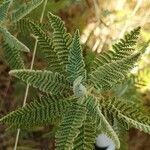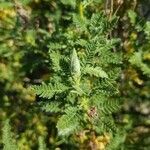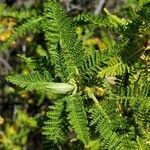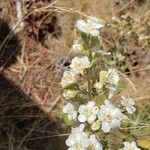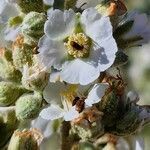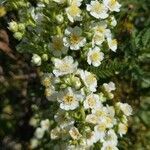Stems: internodes (1–)6–12 mm. Leaves: stipules 2–4 mm, green on leaf base margins; blade 2.6–7(–9.6) × 0.9–2(–3) cm, 1(–2)-pinnate-pinnatifid into 13–25 pairs of pinnae; pinnae oblong-lanceolate, (4–)6–14(–16) × 2–4 mm, divided into 6–10 opposite or alternate pairs of obovate to ovate segments 0.8–2 mm; segments obtuse-rounded, entire or secondarily lobed on proximal margins, proximal margins decurrent along rachillae extending to subtending divisions (pinnae then pinnatifid and leaves then 2-pinnate), pinnae margins of proximalmost lobes decurrent along adaxial leaf rachises, abaxial surfaces of rachises, rachillae, and petioles hairy, adaxial glabrous. Inflorescences 3–15(–23) × 2–8(–12) cm, leafy proximally, flowers crowded along distal branches; lobes of distal bracts and bracteoles acute. Flowers: sepals valvate, 2.5–4 mm, acute, abaxial surface hairy, glandular; petals spreading, margins erose, glabrous; filaments spreading, inner more erect, 3–4 mm, glabrous, anthers orbicular, introrse, versatile, 0.4–0.5 mm; styles 3–5 mm. Follicles reddish brown, leathery, hairy. Seeds yellowish, 2.5–3.5 mm. 2n = 18.
More
A deciduous shrub. It grows 1.5 m high. It has several erect stems. The bark is loose and reddish. The leaves are finely divided into 2 sets of leaflets. The leaves are 10 cm long. The flowers are in dense panicles at the ends of branches. The flowers have 5 white crinkled petals. The flowers are 12 mm across. The fruit are small capsules divided into 5 segments.
It is a temperate plant. It grows naturally between 1,200-2,400 m altitude in the mountains in the USA. It is fairly frost hardy. It grows in cool temperate climates. It needs a dry sunny position. It needs a well drained soil. It suits hardiness zones 5-9.
